
IBM
Gone are the days when complexity in operations was
the sole challenge keeping B2B executives up at night.
The complexity in B2B commerce is greater than ever before.
However, when asked in a recent Aberdeen Group survey to rank
their top challenges, B2B firms placed managing changing
customer behavior above issues such as managing a wide
procurement ecosystem or distribution network (Table 1).
Table 1: B2B Firms are Challenged with Managing Customer Expectations
Source: Aberdeen Group, November 2016
Note: Respondents were allowed to pick up to two answers indicating their top challenges.
Managing customer expectations and behavior involves
monitoring and identifying changes in the way modern business
buyers prefer to purchase products / services and receive support.
FOUR PILLARS TO DRIVE EFFICIENCY &
CUSTOMER LOYALTY IN B2B COMMERCE
November 2016
Customer empowerment has truly been disruptive. B2B commerce firms that have traditionally focused on operational
efficiency now place this empowerment at the top of their list of challenges to be addressed in 2017 and beyond. This
document will highlight how a successful customer-centric strategy transforms B2B firms. It will also describe four key pillars
needed to excel in this area.
Top Challenges (n=196) B2B Firms
Customers are increasingly using digital channels; we need to
be there
47%
Complexity in managing activities across multiple channels
and through various partners
35%
Shortage of top talent for recruitment & ability to retain top
performers
25%
Limited reach to potential buyers of our products / services 24%
Getting customer
experiences right
ultimately helps B2B
firms improve their
financial fortune.
www.aberdeen.com
How Does Managing a Complex
B2B Ecosystem Impact Customer
Experiences?
Complexity affects business
operations; which companies must
manage to meet (and exceed)
customer expectations. Hence,
when companies struggle with
optimizing their operations,
customer experiences will also be
impacted.
For example, if a company fails to
manage its distribution partner
network and creates product
shortage across some distributors,
customers buying that product
from these distributors might not
receive their orders in the
promised timeframe - and hence
become frustrated.
Similarly, if a business such as a
micro-chip producer is out-of-stock
for a chip used to manufacture
smart phones, this will disrupt the
production process of the
customer and will result in
substantial lost sales
opportunities. Hence, the
customer (smart phone
manufacturer) might prefer to
switch to an alternative provider
for its future needs – while
pursuing legal options to
recuperate lost potential revenue.
Companies looking to excel in this area must be agile in
responding to such changes.
While customer experience has become a top priority for B2B
firms, it’s important not to lose sight of the fact that managing
complexity also impacts B2B commerce. In fact, this is the second
top challenge influencing these organizations. Complexity in B2B
commerce arises from the fact that companies need to manage a
distributed supplier network, attain client commitments, and
support distribution partners while ensuring brand consistency
and regulatory compliance.
Managing the complexity of B2B commerce is key to managing
customer experience (see the sidebar). Figure 1 shows why
successfully managing that experience is a truly rewarding
endeavor.
Figure 1: Happy Customers Drives Financial Success
To create the chart above, Aberdeen split our survey respondents
into two categories: those reporting year-over-year improvements
in customer satisfaction and those who saw no or a worsening
improvement. We then looked at company performance for these
firms across several other metrics. Companies in the first group
reported an average annual improvement in customer satisfaction
of 12.1%; those in the second group saw, on average, a 6.8%
12.1% 11.1% 9.9%
7.7%
4.6%
-6.8%
3.3%
-0.8%
-5.4%
0.1%
-8%
-6%
-4%
-2%
0%
2%
4%
6%
8%
10%
12%
14%
Customer
satisfaction
Brand
awareness
Customer
lifetime value
Average
customer
spend
Product
margins
Ye
ar
-o
ve
r-y
ea
r
pe
rc
en
t c
ha
ng
e
n=196
B2B Firms Reporting Improvements in Customer Satisfaction
B2B Firms Reporting No Improvements in Customer Satisfaction
Source: Aberdeen Group, November 2016
www.aberdeen.com
Why is Customer-Centricity
Becoming a Top Priority for B2B
Firms?
There are a plethora of reasons
why B2B firms are placing greater
emphasis on addressing customer
expectations than ever before.
First, is the increasing
understanding that competing
based on superior products or
services alone is no longer enough.
With the pace of change in
technology, barriers to entry across
many markets have been reduced
or almost completely disappeared.
As a result, companies are
beginning to focus on customer
experience as a differentiator.
Another reason is changing
workplace demographics. There
are more tech-savvy business
buyers than a decade ago. The
same expectations that influence
how these buyers make purchase
decisions as consumers also
largely affect their expectations
when making business purchases.
It’s imperative that B2B firms
understand the trends impacting
consumer behavior and find
effective ways to meet the
expectations of the modern B2B
buyer.
annual worsening in this area. This reflects an 18.9% delta
between the two groups, a significant gap validating that
companies in the former category have truly mastered how to
delight customers.
Happy customers are more likely to remain customers,
maintaining and potentially even growing their spend over time.
Indeed, Figure 1 shows that B2B firms that improve customer
satisfaction year-over-year also enjoy significant annual growth in
customer lifetime value and average client spend. In regards to
the former metric, B2B purchases generally have higher price
points than B2C purchases. As such, this means that the benefits
of meeting customer expectations are amplified for B2B firms.
Given the connection of how managing complexity influences
customer satisfaction results, the success of B2B firms in achieving
improvements in customer satisfaction also signals their ability to
navigate a complex landscape. Let’s now take a closer look at the
four key ways B2B firms manage both complexity and customer
expectations.
Creating Happy Customers & Driving Operational Efficiency
Data shows that the web has become a ubiquitous channel in B2B
commerce; 92% of B2B firms currently use it as part of their
activities. However, very few B2B transactions take place over the
web. In fact, recent research revealed that less than 10% of total
B2B sales in the US are generated through the web. At the same
time, other research shows that online sales for B2B firms are
projected to grow by a compound annual rate of 7.7%.
Put together, the aforementioned findings indicate that online
sales are poised to transform B2B commerce. In order to take
advantage of this transformation, companies must establish the
necessary building blocks. Figure 2 shows that B2B firms that excel
when it comes to creating happy customers are 43% more likely
(77% vs. 54%) to have a process in place to regularly monitor the
company website to ensure up-time. This activity helps companies
www.aberdeen.com
minimize the likelihood that customers will not be able to access
the website to purchase products or receive support. As the web
becomes a greater source of B2B revenue, ensuring consistent
web performance becomes essential.
Figure 2: Four Steps to Customer Delight in B2B Commerce
Companies with improving customer satisfaction rates also make
effective use of content. For example, these organizations are 42%
(68% vs. 48%) more likely to seamlessly integrate their marketing
activities with web store content. This essentially refers to aligning
inventory management activities, marketing activities, and web
content activities. The absence of such alignment might result in
the company sending marketing messages promoting a product
running low in inventory. This, in turn, would frustrate buyers who
might not be able to purchase a promoted product because it was
sold out. Other challenges B2B firms might face include contacts
placing restrictions on the products a customer can purchase.
Without visibility into such restrictions, companies risk compliance
with internal or external commitments.
Similarly, a lack of alignment between inventory management and
web store content might mean that the company risks displaying
an item as available that it can’t deliver. Even if the customer may
77% 75%
68%
62%54%
40%
48%
34%
0%
20%
40%
60%
80%
Regularly monitor
company website to
ensure up-time
Align trade
promotions with
inventory
management
activities
Integrate marketing
campaign activities
with web store
content
Deliver consistent
messages to buyers
across multiple
channels
Percent of respondents, n=196
B2B Firms Reporting Improvements in Customer Satisfaction
B2B Firms Reporting No Improvements in Customer Satisfaction
Source: Aberdeen Group, November 2016
Aligning customer
communications with
inventory management
activities is vital.
Companies that fail to do
so risk frustrating
customers, lose sales
opportunities and pave
the way for potential
litigations for failure to
meet customer
commitments.
www.aberdeen.com
eventually receive the product, the damage, in terms of customer
frustration, is already done.
Beyond impacting net-new sales opportunities, lack of alignment
between inventory management activities and customer
interactions also affects organization’s ability to address current
customer entitlements. For example, if the company commits to
deliver 15,000 engines to a client within a certain period, and fails
to meet this commitment, this might open the door for potential
litigation. Data shows that businesses that achieve substantial
improvements in customer satisfaction and operational efficiency
are 88% more likely to have established seamless integration
between their inventory management activities and customer-
facing interactions, such as marketing campaigns and updating the
online store content.
Despite some of the challenges B2B firms face in adapting to the
new normal of customer empowerment, the good news is that
they can learn from the experiences of their B2C counterparts.
Over the past several years, B2C firms have learned that simply
using multiple channels to interact with customers is no longer
enough. Instead, they must use these channels to deliver truly
personalized and consistent conversations, only then do they
maximize their ability to build profitable and enduring customer
relationships. Activities designed to deliver such consistent and
personalized interactions are often referred as omni-channel
programs. Figure 2 reveals that B2B firms that excel in creating
happy customers indeed utilize the learnings of their B2C
counterparts. They are 82% more likely (62% vs. 34%) to deliver
omni-channel conversations.
Key Takeaways
Achieving success as a B2B firm in today’s marketplace is harder
than ever before. In addition to navigating an ever more complex
ecosystem, these firms must also constantly find ways to adapt to
and address rapidly evolving customer needs. Unfortunately,
companies don’t have the option to choose which challenge to
B2B firms have the
unique opportunity to
learn from the
experiences of their B2C
counterparts. These
experiences reveal that
delivering omni-channel
conversations helps
improve customer
satisfaction and grow
spend.
www.aberdeen.com
address. Mitigating complexity influences an organization’s ability
to improve customer experiences. Similarly, if customer
expectations are not met, this can put a strain on the B2B
ecosystem as businesses scramble to address these needs in order
to avoid losing customers.
B2B firms that address the challenges highlighted thus far reap
significant rewards, such as increased product margins, happy
customers, and growth in client spend. Below is a list of the four
key steps they must follow to accomplish these results. If you’re
not currently employing these best practices, we highly
recommend you to do so.
Î Regularly monitor the company website and ensure its up-
time
Î Integrate marketing activities with online store content
Î Align inventory management activities with customer
interactions
Î Establish an omni-channel program
Author: Omer Minkara, VP & Principal Analyst, Contact Center & Customer
Experience Management
About Aberdeen Group
Since 1988, Aberdeen Group has published research that helps businesses worldwide improve their performance. Our analysts
derive fact-based, vendor-agnostic insights from a proprietary analytical framework, which identifies Best-in-Class
organizations from primary research conducted with industry practitioners. The resulting research content is used by
hundreds of thousands of business professionals to drive smarter decision-making and improve business strategy. Aberdeen
Group is headquartered in Waltham, MA.
This document is the result of primary research performed by Aberdeen Group and represents the best analysis available at
the time of publication. Unless otherwise noted, the entire contents of this publication are copyrighted by Aberdeen Group
and may not be reproduced, distributed, archived, or transmitted in any form or by any means without prior written consent
by Aberdeen Group.
14297




















